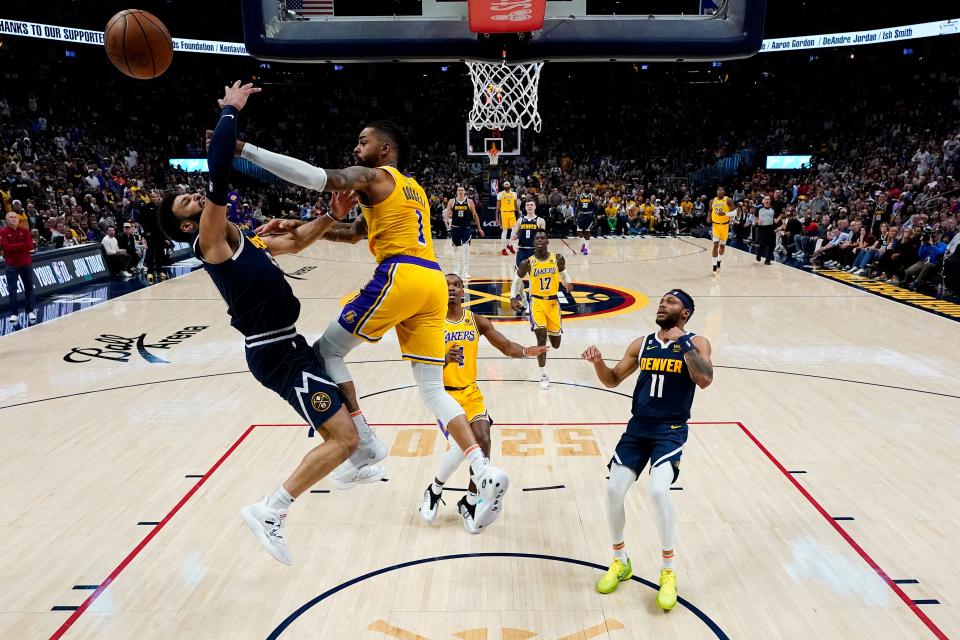Questionable call on Lakers' D'Angelo Russell sparks debate: What is a flagrant 1 foul?
“Soft” began trending on Twitter on Thursday evening after Los Angeles Lakers star D'Angelo Russell was called for a Flagrant 1 foul against Denver Nuggets' Jamal Murray during Game 2 of the Western Conference Finals.
With the Lakers up 23-20 in the first quarter, Murray intercepted a pass from Dennis Schroder and sprinted up the court for a layup, but he was fouled in transition by Russell, who hit Murray's arm and face while contesting the shot. Referees initiated a review of the foul and upgraded it to a Flagrant 1 because of Russell's wind-up and contact.
"This league astounds me! What do we want D'Angelo Russell to do? Get out of the way?" Jeff Van Gundy said during ESPN's broadcast. Mark Jackson added: "What happened to the game I love?"
LeBron James appeared to be in disbelief when the ruling was announced. Golden State Warriors star Draymond Green tweeted, "Soft."
The questionable call rehashed the conversation of what differentiates a common foul from a Flagrant 1 and Flagrant 2 foul. What is the difference between the two? Let's revisit the rules amid the 2023 NBA Playoffs:
OPINION: Nikola Jokic 1, Anthony Davis 0: Nuggets' two-time MVP wins first battle with Lakers star
The latest Jeff Van Gundy rant on NBA officiating.
"This league astounds me! What do we want D'Angelo Russell to do? Get out of the way?"- JVG
"I'm just saying the reason they called it is the wind-up."- Mike Breen
"What wind-up?!"- JVG
🏀📺🎙️🦓 https://t.co/9AiDvfA8N0 pic.twitter.com/VVWPcREHPd— Awful Announcing (@awfulannouncing) May 19, 2023
What is the criteria for flagrant fouls?
According to the 2022-23 NBA rule book, referees look at the following factors to determine a flagrant foul:
The severity of the contact
Whether or not the player was making a legitimate basketball play (e.g., whether a player is making a legitimate effort to block a shot; note, however, that a foul committed during a block attempt can still be considered flagrant if other criteria are present, such as recklessness and hard contact to the head)
Whether, on a foul committed with a player’s arm or hand, the fouling player wound up and/or followed through after making contact
The potential for injury resulting from contact (e.g., a blow to the head and a foul committed while a player is in a vulnerable position)
The severity of any injury suffered by the offended player
The outcome of the contact (e.g., whether it led to an altercation)

What is a flagrant foul 1?
A flagrant 1 is "unnecessary contact committed by a player against an opponent. The opposing team is awarded two free throws and possession." A player that commits two flagrant 1 fouls in the same game is automatically ejected.
What is a flagrant foul 2?
The league defines a flagrant 2 as "unnecessary and excessive contact committed by a player against an opponent. The opposing team is awarded two free throws and possession and the player committing the foul is automatically ejected."
What is the difference?
The difference between a flagrant 1 foul and a flagrant 2 foul is "excessive contact."
For example, Philadelphia 76ers star Joel Embiid received a flagrant foul 1 for kicking Brooklyn Nets big man Nic Claxton near the groin area in Game 3 of the first round, although the move appeared intentional. James Harden, however, was assessed a flagrant foul 2 and tossed from the game after he appeared to strike the Nets' Royce O'Neale in the groin area while trying to create separation with his left arm, although it appeared accidental.
Crew chief Tony Brothers explained that Embiid’s kick was "unnecessary," but it wasn’t deemed excessive or a flagrant 2 because of the "point of contact to the leg.” Harden, however, was assessed a flagrant 2 and ejected because of "the point of contact directly to the groin" of O’Neale with his hand, Brothers said.
Can NBA referees review every foul?
Much to Van Gundy's annoyance, referees are allowed to review fouls to determine whether it is a flagrant and can reclassify a common foul if it meets the criteria. The league can assess suspensions and fines to any player that commits a flagrant foul.
This article originally appeared on USA TODAY: Flagrant foul or no? NBA fans debate questionable call on Lakers star

